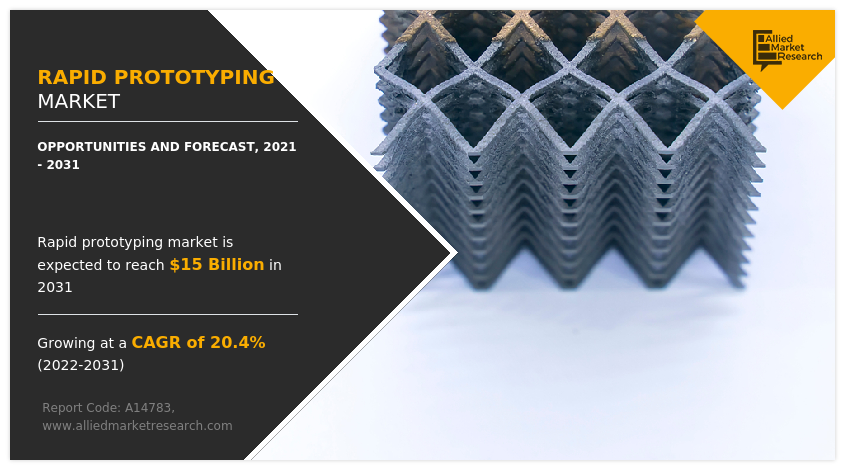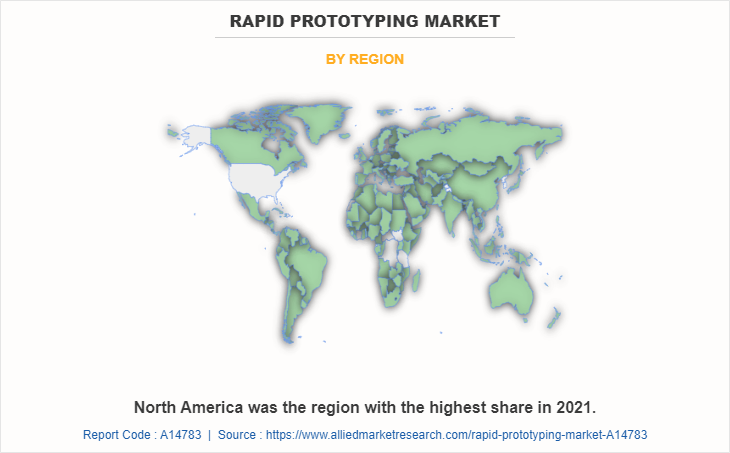Rapid Prototyping Market Research, 2031
The global rapid prototyping market was valued at $2.5 billion in 2021 and is projected to reach $15 billion by 2031, growing at a CAGR of 20.4% from 2022 to 2031. Rapid prototyping is a quick way of fabricating a physical part, model, or assembly using 3D computer-aided design (CAD). It creates product simulations for testing and validation during the product development process, with multiple iterations generated during a short period based on user feedback and analysis. The creation of the part, model, or assembly is usually completed using additive manufacturing, more commonly known as 3D printing. However, other technologies used for rapid prototyping include high-speed machining, casting, molding, and extruding.
The rapid prototyping 3D printing industry is driven by the rise in demand for customization of products to gain a competitive advantage. The use of rapid prototyping for the in-house development of prototypes is projected to lead to the regular introduction of products. Rapid prototyping delivers quick visualization of the final product and eliminates time-consuming processes of outsourcing; therefore, this acts as a major driving factor for increasing the scope of the rapid prototyping market. Further, Traditional prototyping machines can utilize only one type of material; however, modern rapid prototyping equipment can utilize multiple materials simultaneously. They support a wide variety of materials such as polymers, ceramics, and metals for printing. This technology is expected to reduce the cost of overhead required for manufacturing. The utilization of materials is done efficiently, and no excess material is used in unwanted spaces.

On the other hand, the high cost related to rapid prototyping, along with the need for skilled professionals, is holding back the market. If a manufacturing company adopts rapid prototyping technology, it will eventually result in a high initial investment. Furthermore, the software required to run rapid prototyping is expensive. As the application area changes, rendering software needs to be changed, thereby increasing the cost of the entire system. Software needs to be updated periodically to keep it efficient and effective. In the future, as software development reaches maturity, the price of software packages is expected to decrease.
In the meantime, digital manufacturing’s increased adoption of rapid prototyping is expected to boost the market in the forecast period. Artificial intelligence (AI), augmented reality (AR), advanced robotics, smart devices, and 3D printing have revolutionized the manufacturing process in various industries. Decentralization in 3D printing is expected to determine the future of rapid prototyping in the next few years. 3D printing has led to significant advancements in heavy industry, automotive, consumer products, medical, healthcare, and aerospace sectors. Rapid prototyping services help the manufacturing industry by promoting quick product development. They enable lean manufacturing and boost product adaptability. These technological advancements in the sector assure high product customizations and boost revenues.
Segment Overview
The rapid prototyping industry is segmented into the Material, Technology, and End User industries.
Based on material, the rapid prototyping market size is segmented into thermoplastics, metals & alloys, ceramics, and others. In terms of market segmentation by material, the market was dominated by the thermoplastics segment in 2021, whereas the metals and alloys segment is expected to witness a higher growth rate during the forecast period. Thermoplastics or plastic rapid prototyping are extensively used for rapid prototyping due to their availability, ease of use, strength & durability, cost-effectiveness, and versatility.
By Material
Thermoplastics segment dominated the market in 2021.
By technology, the rapid prototyping market share is classified into stereolithography (SLA), selective laser sintering (SLS), digital light processing (DLP), fused deposition modeling (FDM), and others. In terms of market segmentation by technology, the market was dominated by the stereolithography segment in 2021, whereas the fused deposition modeling segment is expected to witness a higher growth rate during the forecast period. The factors driving the stereolithography technology market growth include a wide choice of materials available, high resolution, shortened development cycles, and highly accurate & durable outputs.
By Technology
Stereolithography was the dominant segment in 2021.
By end-user industry, the rapid prototyping market growth is categorized into aerospace & defense, healthcare, manufacturing & construction, consumer goods & electronics, and others. In terms of market segmentation by end-user industry, the market was dominated by the manufacturing and construction segment in 2021, whereas the consumer goods and electronics segment is expected to witness a higher growth rate during the forecast period. The increase in the need of consumers for new & varied products and the rise in disposable income of people are some important growth opportunities for rapid prototyping in this market.
By End User Industry
Manufacturing and construction was the largest segment in 2021.
By region, the rapid prototyping market analysis is carried out across North America, Europe, Asia-Pacific, and LAMEA. In terms of region, the market was dominated by North America in 2021, even though the Asia-Pacific is expected to grow at a faster rate during the forecast period. North America is one of the major regions in the global rapid prototyping market, in terms of revenue generation and market share. Key players operating in this region, such as Stratasys Ltd. and Systems Corporation, have been adopting various strategies to provide advanced solutions, which is expected to fuel market growth, leading to its high market share.

Competitive Analysis
Competitive analysis and profiles of the major rapid prototyping market players that have been provided in the report include 3D Systems, Inc., 3DFortify, Inc., Arcam AB (General Electric), Carbon 3D, Desktop Metal, Inc., ExOne Company, Hoganas AB, Markforged, Optomec, Inc., and Stratasys, Ltd. These key players adopt several strategies such as new product launch and development, acquisition, partnership and collaboration, and business expansion to increase their market share in the global rapid prototyping market during the forecast period.
Top Impacting Factors
Some of the significant factors impacting the global rapid prototyping market forecast include the rise in demand for the customization of products to gain a competitive edge and the surge in the adoption of multiple materials for prototyping. On the other hand, the high costs related to rapid prototyping, along with the requirement for skilled professionals, act as a restraint on the market. Meanwhile, the increase in the adoption of rapid prototyping in digital manufacturing is an opportunity during the forecast period.
Historical Data & Information
The rapid prototyping market outlook is fairly competitive, owing to the strong presence of existing vendors. Market vendors are expected to gain a competitive advantage over their competitors because they can cater to market demands with a wide range of products. The competitive environment in this market is expected to increase as technological innovations, product extensions, and different strategies are adopted by key vendors.
Key Developments/Strategies
3D Systems, Inc., 3DFortify, Inc., Arcam AB (General Electric), and Carbon 3D are among the top companies that hold a prime share in the rapid prototyping market opportunity. Top market players have adopted various strategies, such as product launches, contracts, and others, to expand their foothold in the rapid prototyping market.
- In September 2021, 3D System Corporation expanded its material portfolio with the launch of Certified Scalmalloy (A) and Certified M789 (A). This material will be used to develop high-strength parts for energy, mold-making, automotive, electronics, aerospace, and defense applications. Also, the consumer can use a direct metal printing platform to develop parts with the help of Scalmalloy (A) and M789 (A).
- In January 2020, GE Additive signed a five-year cooperative research and development agreement with ORNL to combine the lab's research capabilities with GE's experience in developing real-world products. The agreement is an extension of ORNL's work with Arcam, a company GE acquired in 2016. Arcam manufactures refrigerator-sized 3D printers that use electron beams to weld together millions of grains of fine-powdered metal, one hair-thin layer at a time, to build things like intricately detailed jet engine parts.
- In November 2021, Desktop Metal, Inc. completed its acquisition of the ExOne Company. This acquisition reinforces Desktop Metal's leadership in additive manufacturing (AM) for mass production. ExOne extends Desktop Metal's product platforms with complementary solutions to create an unparalleled AM portfolio that offers industry-leading throughput, flexibility, and materials breadth, providing customers with a variety of options to address their specific applications.
Key Benefits for Stakeholders
- This report provides a quantitative analysis of the market segments, current trends, estimations, and dynamics of the rapid prototyping market from 2021 to 2031 to identify the prevailing rapid prototyping market opportunities.
- The market research is offered along with information related to key drivers, restraints, and opportunities.
- Porter's five forces analysis highlights the potency of buyers and suppliers to enable stakeholders to make profit-oriented business decisions and strengthen their supplier-buyer network.
- In-depth analysis of the rapid prototyping market segmentation assists in determining the prevailing market opportunities.
- Major countries in each region are mapped according to their revenue contribution to the global market.
- Market player positioning facilitates benchmarking and provides a clear understanding of the present position of the market players.
- The report includes an analysis of the regional as well as global rapid prototyping market trends, key players, market segments, application areas, and market growth strategies.
Rapid Prototyping Market Report Highlights
| Aspects | Details |
| Market Size By 2031 | USD 15 billion |
| Growth Rate | CAGR of 20.4% |
| Forecast period | 2021 - 2031 |
| Report Pages | 321 |
| By Material |
|
| By Technology |
|
| By End User Industry |
|
| By Region |
|
| Key Market Players | Desktop Metal, Inc., Hoganas AB, ExOne Company, Arcam AB (General Electric), 3DFortify, Inc., 3D Systems, Inc., Stratasys, Ltd., Markforged, Optomec, Inc., Carbon 3D |
Analyst Review
The rapid prototyping market exhibited development potential across different sectors including aerospace, healthcare, and electronics industry. Furthermore, technological advancements, such as the development of new materials and manufacturing processes, drive the demand for more efficient rapid prototyping technology.
The rapid prototyping market is highly competitive owing to the strong presence of existing vendors. Rapid prototyping market vendors are investing substantially in R&D and skilled workforce and are anticipated to gain a competitive edge over their rivals. The competitive environment in this market is expected to further intensify with an increase in technological innovations, product extensions, and different strategies adopted by key vendors.
The market for rapid prototyping has grown rapidly in recent years, driven by increase in demand for fast product development cycles, reduced costs, and improved product quality. Furthermore, the market expansion is being driven by factors such as rise in adoption of 3D printing technology in various industries, such as aerospace, automotive, and healthcare, as well as the surge in demand for customized products.
Manufacturing and construction are the leading end user industry of rapid prototyping market
North America is the largest regional market for rapid prototyping
The rapid prototyping market size was valued at $2.4 billion in 2021, and is projected to reach $14.9 billion by 2031, registering a CAGR of 20.4%.
The key players operating in the rapid prototyping market are 3D Systems, Inc., 3DFortify, Inc., Arcam AB (General Electric), Carbon 3D, Desktop Metal, Inc., ExOne Company, Hoganas AB, Markforged, Optomec, Inc. and Stratasys, Ltd.
Stereolithography is the leading technology used in rapid prototyping market
Loading Table Of Content...
Loading Research Methodology...



